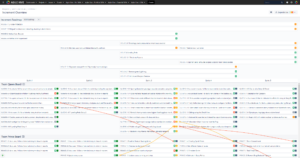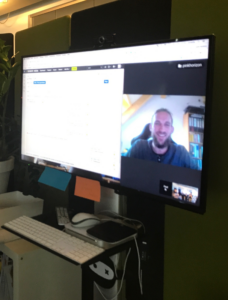Countless businesses today employ remote workers as standard practice. They’re flexible and easy to source, and the financial savings on office space and other overheads are considerable.
But with team members working remotely from anywhere around the world, team cohesion is often impacted as a result. Employers should take care to integrate remote workers and create a team culture that works for the business as a whole.
With that in mind, read on for a few tips on how to help your remote workers become a cohesive team.
Embrace dedicated collaborative technology to boost cohesion
By definition, remote workers rely heavily on technology in order to work. When your team is spread far and wide, technology keeps them all connected and on task.
But while you probably use basic software tools to ensure your employees stay in touch with each other — messaging apps such as Slack or shared Google Drives, for instance — it’s always worth looking to better, more comprehensive technologies to optimize your remote worker infrastructure.
Atlassian products are perhaps the best examples of this.
For starters, there is Atlassian’s content development and publishing software, Confluence. Open, accessible, and easy to use, Confluence provides a single interface for workers to collaborate on documents.
There’s also Agile Hive, //SEIBERT/MEDIA’s software, based on Atlassian Jira and Confluence which is used to coordinate agile project management. This technology helps employees overcomes the in-person limitations of traditional agile working to oversee, manage, and report on projects of all sizes in real-time.
And there are other third-party tools that integrate seamlessly with Atlassian products too. Take draw.io, for example. This is a simple free online diagram tool for creating organizational charts, flowcharts, process diagrams, and similar visual content. Its integration with Confluence means teams can collaborate visually on their ideas and document their products effectively.
Beyond Confluence, it also integrates with Google Drive and OneDrive. draw.io will slot perfectly into your existing remote worker infrastructure.
And for messaging? Atlassian recently partnered with Slack to create a cohesive messaging tool that keeps remote workers connected, wherever they are.
Make sure everyone feels valued, no matter where they are
When you’re dealing with remote workers, it can be easy to neglect an employee who isn’t in the office. You don’t see them every day as you do your other workers. Consequently, it’s even easier for them to feel detached from the business and its specific goals.
As a result, remote workers can feel like nothing more than just another number, negatively impacting their motivation and engagement as a result.
So it’s worth taking the time to not just acknowledge your remote employee, but provide them with genuine feedback tailored to their role and responsibilities. This helps reassure remote workers that they are an important part of the business.
Include examples of how their work has positively impacted the rest of the business as part of the feedback process. This helps them understand the effect of their work beyond what they can immediately see.
Tailor your feedback to specific individuals too, rather than offering generic praise to a team. This reminds remote workers that their work is valued, and not swept up in that of their colleagues. And remember to keep it authentic — token praise when it’s not deserved is patronizing rather than rewarding, and it carries more weight too.
And if you have to give negative feedback, try to sandwich it between positive praise to lessen the blow. This helps your remote workers feel valued, whilst simultaneously encouraging them to work harder.
It’s also worth using feedback loops too. While these are typically used for customer-centric feedback, they are also vital for improving internal business culture.
Give your employees opportunities to voice their concerns about their role as a remote worker. Use this information to make improvements to your remote working infrastructure, based on their genuine and honest feedback.
Remember to let your employees know that feedback is a safe space — there will be no repercussions for negative feedback. Anonymous surveys are a good way of sourcing this feedback.
Encourage collaboration with internal projects
The typical business is divided into teams, separate groups that may or may not liaise with each other. Or if they do need to communicate, it’s only on an infrequent basis — not enough for them to develop any sort of meaningful relationship.
And when a remote worker is in such a team, their disconnect reduces that ability even further.
While every employee in a business is working towards the same goal, they often lack opportunities that require them all to pitch in and collaborate together on a single project.
But launching a collaborative side project, that doesn’t have to relate to your business’s goals, can be a rewarding experience that requires all team members to communicate and collaborate, regardless of which team they are in.
One example of this is launching an internal business project, like a blog or an online store. Blogs are simple enough to build, and starting an eCommerce venture is easy. There are plenty of easy-to-use apps and tools that negate the need for complicated coding, so it’s simple to get such a project off the ground quickly.
Assign tasks to each remote worker (for instance, product sourcing, theme design, and so on) and encourage them to collaborate together to build a profitable venture. While your team likely has the requisite skills between them to accomplish this, most SaaS platforms offer resources and guides by default to help your remote team succeed. As well as increasing team cohesion, you’ll build their skillset, enhance their project management skills, and boost confidence as a result.
Plus, such a project also provides a safe space to practice using the collaborative software mentioned above too, without running the risk of impacting client work.
The benefits of remote workers far outweigh the challenges posed by remote work. But it’s still up to employers to integrate their remote workers into a coherent team and create a solid business culture.
Follow the tips above and transform your scattered digital employees into a connected team that helps your business grow.
Kayleigh Alexandra is a writer and campaign designer for MicroStartups, a website focused on helping charities and microbusinesses. After years of working in sustainability, marketing, and creative industries, Kayleigh now loves to devote her time to supporting other businesses to grow and thrive.
Visit her blog or follow her on Twitter @getmicrostarted for the latest news, tips, and advice for startups and solopreneurs.






